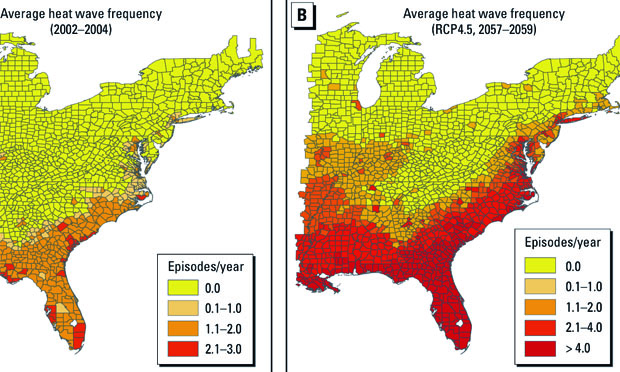According to a 2008 report by the federal U.S. Climate Science Program, global warming is likely to result in “increased costs to human health and well being” in the United States. Climate change threatens human health in several ways — by increasing the frequency of extreme weather events, reducing air quality, and allowing infectious disease to spread. Additionally, heat waves – which can be fatal particularly for the elderly — are already on the increase.
A 2014 study published in Environmental Health Perspectives, “Estimation and Uncertainty Analysis of Impacts of Future Heat Waves on Mortality in the Eastern United States,” predicts the number of heat wave-related deaths in U.S. counties east of the Mississippi River for the years 2057-59. The researchers — based at Emory University, the University of Tennessee and George Washington University — used climate models developed by the National Center for Atmospheric Research to estimate potential changes in temperature, heat wave frequency and subsequent deaths in the region.
The study’s findings include:
- Compared to 2002-04, heat waves will occur 3.5 to 6.4 times more frequently in the eastern United States over the period 2057-59.
- The number of deaths attributable to heat waves is expected to increase 7.5- to 19.0-fold over this period. This represents an increase from approximately 187 such deaths each year during the period 2002-04 to as many as 3,556 deaths per year in 2057-59.
- There was a high level of uncertainty in the projected figures for heat wave-related deaths because, among other assumptions, the researchers had to estimate future population levels for the region and future greenhouse gas emissions.
- According to the researcher’s model, taking measures to curb greenhouse gas increases results in relatively fewer heat wave-related deaths when compared to a scenario that allows greenhouse gas emissions to increase unabated.
The authors conclude: “Under the fossil fuel-intensive RCP 8.5 scenario, the probability of thousands of heat wave-related deaths per year in the eastern United States is much higher than under the [medium-low emissions] RCP 4.5 scenario. Effective mitigation and adaptation measures will be crucial to reduce the potential for catastrophic outcomes, particularly in the most vulnerable geographic regions.”
Related research: A 2014 study in Proceedings of the National Academy of Science, “Summer Temperature Variability and Long-term Survival among Elderly People,” looks at the relationship between outdoor temperatures and deaths among the elderly. Also of interest are “Urban Adaptation Can Roll Back Warming of Emerging Megapolitan Regions” which looks at the potential of large-scale urban adaptation strategies to counteract the effects of long-term global climate change, and “Avoided Heat-Related Mortality through Climate Adaptation Strategies in Three U.S. Cities.”
Keywords: greenhouse gases, climate change, global warming, aging


Expert Commentary